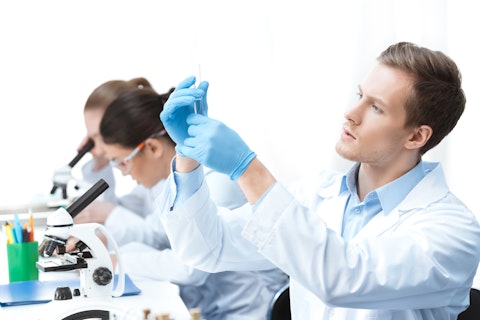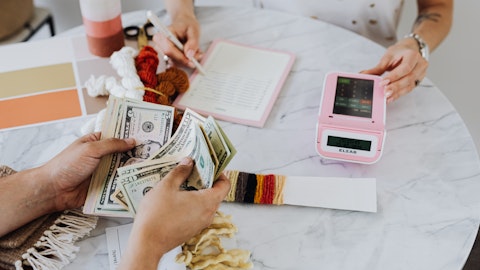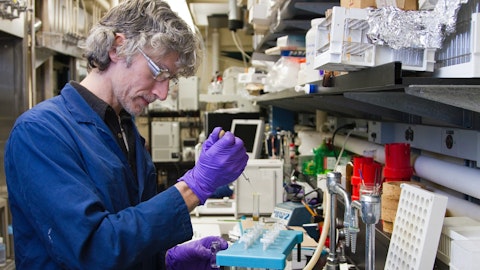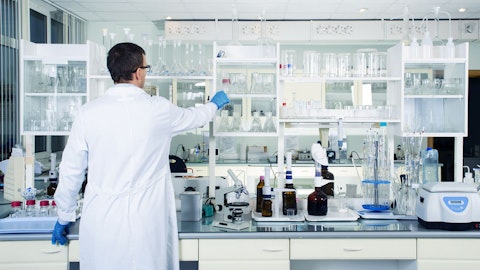Stepan Company (NYSE:SCL) Q1 2023 Earnings Call Transcript April 25, 2023
Stepan Company misses on earnings expectations. Reported EPS is $0.71 EPS, expectations were $0.94.
Operator: Welcome to the Q1 2023 Stepan Company Earnings Conference Call. At this time, all participants are in a listen-only mode. After the speakers’ presentation, there will be a question-and-answer session. . Please be advised that today’s conference is being recorded. I would now like to hand the conference over to Luis Rojo, Chief Financial Officer. Please go ahead.
Luis Rojo: Good morning and thank you for joining Stepan Company’s first quarter 2023 financial review. Before we begin, please note that information in this conference call contains forward-looking statements, which are not historical facts. These statements involve risks and uncertainties that could cause actual results to differ materially, including, but not limited to, prospects for our foreign operations, global and regional economic conditions and factors detailed in our Securities and Exchange Commission filings. Whether you’re joining us online or over the phone, we encourage you to review the investor slide presentation, which we have made available at www.stepan.com under the Investors section of our website. We made these slides available at approximately the same time as when the earnings release is issued.
And we hope that you find the information and perspective helpful. With that, I would like to turn the call over to Mr. Scott Behrens, our President and Chief Executive Officer.
Scott Behrens: Good morning and thank you all for joining us today to discuss our first quarter results. To begin, I will share our first quarter highlights and strategic outlook, while Luis will provide additional details on our financial results. The company reported first quarter adjusted net income of $16.4 million. Earnings was significantly impacted by a 14% decline in volume, driven by softening market demand, delays in the startup of new low 1,4 dioxane production assets, and continued customer and channel destocking across most of our markets. Our margins were in line with expectations despite high cost inventory carryover from the fourth quarter and increased competitive activity within certain end use markets. Despite ongoing inflationary pressures and higher cash expenses related to the construction and pre-commissioning activities of our new alkoxylation investment in Pasadena, Texas, and the startup of our new low 1,4 dioxane capacity in the US, we kept cash expenses consistent year-over-year.
For the quarter, adjusted EBITDA was $48.7 million, down $31 million versus Q1 2022, primarily driven by the decline in sales volume. Surfactants operating income was $27.1 million versus $53.8 million in the prior year, primarily due to a 13% decline in global sales volume that was partially offset by improved product and customer mix. The lower sales volume was mostly due to lower global commodity laundry demand, low 1,4 dioxane transits and startup delays, and the previously disclosed backward integration by one customer. Volumes were also negatively impacted by lower demand within the North American personal care end market and customer inventory destocking. Higher global demand in the agricultural end market partially offset the declines.
Polymers operating income was $10 million, a decrease of $4 million versus the prior year or 28%. This decrease was primarily due to an 18% decline in global sales volume, led by a 19% volume decline in rigid polyols. Lower phthalic anhydride volumes were partially offset by slightly higher specialty polyol volumes. The lower demand in rigid polyols reflects customer and channel inventory destocking and lower construction related activities. Specialty Products operating income was $2.5 million versus $3.7 million in the prior year. This decrease was primarily attributable to lower sales volume and margins within the medium chain triglycerides product line. Our board of directors declared a quarterly cash dividend on Stepan’s common stock of $0.365 per share, payable on June 15, 2023.
Stepan has paid and increased its dividend for 55 consecutive years. During the first quarter of 2023, the company paid $8 million in dividends to shareholders. The company did not purchase any company stock in the first quarter of 2023 and has $125 million remaining under the share repurchase program authorized by its board of directors. We remain confident in the strength and diversity of our business and its ability to generate cash that will allow us to continue to invest in our business, pursue strategic M&A opportunities and return cash to our shareholders. Luis will now share some details about our first quarter results.
Luis Rojo : Thank you, Scott. My comments will generally follow the slide presentation. Let’s start with slide 4 to recap the quarter. Adjusted net income was $16.4 million or $0.71 per diluted share versus $40.7 million or $1.76 per diluted share in the prior year. Because adjusted net income is a non-GAAP measure, we provide full reconciliations to the compatible GAAP measures. And these can be found in Appendix 2 of the presentation and Table 2 of the press release. Specifically, the adjusted net income for the first quarter excludes deferred compensation income of $0.1 million compared to income of $4.4 million last year. It also excludes minor business restructuring expenses and environmental remediation costs. The deferred compensation figures represent the net income related to the company deferred compensation plans as well as cash settled stock appreciation rights for our employees.
Because these liabilities change with the movement in the stock price, we’ll exclude this item from operational discussion. The effect of foreign currency translation negatively impacted net income by $0.9 million or $0.04 per diluted share versus the prior year. Slide 5 shows the total company’s net income bridge for the first quarter compared to last year first quarter and break down the decrease in adjusted net income. Because this is net income, the figures noted here are on an after tax basis. We will cover each segment in more detail, but to summarize, we experienced lower operating income in all segments driven by lower volumes. Despite significant inflation, our cash expenses were similar to last year. Adjusted corporate expenses and all other which are not allocated to the business segments were up due to higher interest expenses and overall inflation.
The company effective tax rate was 19% in the first quarter of 2023 versus 24.6% in the first quarter of 2022. This decrease was primarily due to more favorable tax benefits derived from stock-based compensation awards exercise or distributed in the first quarter of 2023 versus the first quarter of 2022. Slide six focuses on Surfactants segment result for the quarter. Surfactants net sales were $468 million for the quarter, flat versus the prior year. Selling prices were up 14%, mainly due to the pass through of higher raw materials and logistics costs, as well as improved product and customer mix. Volume declined 13% year-over-year, primarily due to lower global demand in commodity laundry, the startup delays associated with the low 1,4 dioxane transition, lower demand within the North America personal care end market and continued customer and channel inventory destocking.
Higher global demand for products sold into the agricultural end markets partially offset the above. Foreign currency translation negatively impacted net sales by 1%. Surfactants operating income for the quarter decreased $27 million versus the prior year. This reduction was driven by a volume decline of 13% and higher expenses associated with the company transition to low 1,4 dioxane products and Pasadena pre-operating expenses. Operating income declined in all Surfactants regions, primarily due to the lower volumes mentioned before. Now turning to Polymers on slide 7. Net sales were $161 million for the quarter, a 14% decrease versus the prior year. Global volume declined by 18%, primarily due to a 19% volume decline in rigid volumes. This was partially offset by double-digit volume growth in China and mid-single digit growth in North America CASE business.
The lower demand reflects customer and channel inventory destocking and lower construction-related activities. Selling prices increased 8% primarily due to the pass-through of higher raw material and input costs. Foreign currency translation negatively impacted net sales by 4%. Polymers operating income was $10 million, a decrease of $4 million versus the prior year. The decrease is primarily due to the 18% decline in global volume. North America and Europe results were impacted by lower volumes. Asia results improved on increased demand following the reopening of China. Finally, Specialty Products net sales were $23 million for the quarter, a 13% increase versus the prior year. Sales volume was down 7% between years, while operating income decreased $1.2 million.
The decline in operating income was primarily attributable to lower volumes and margins within MCT product line. Turning to slide 8, our balance sheet remains healthy, and we have ample liquidity to invest in the business. Our leverage and interest coverage ratios remain well managed despite our elevated CapEx spending in the first quarter. For the first quarter, cash from operations was $42 million and we deployed $214 million against CapEx investment, payments of accrued liabilities, dividends and higher working capital requirements. The company’s first quarter capital spend was $92 million, inclusive of our 1,4 dioxane project and Pasadena investments in the US. Now on slide 9 and 10, Scott will update you on our strategic priorities.
Scott Behrens : These slides describe our strategic priorities and operating principles for shareholder value creation. We believe our growth strategy is properly aligned to attractive growth vectors within our core markets, and we are committed to delivering greater productivity through efficient allocation of resources to increase value creation for shareholders. Our customers will always remain at the center of our strategy and innovation. Our longstanding tier 1 customers value our technical capacity and the ability to manufacture and deliver quality products at the scale they need. We continue to diversify our customer base by expanding our global reach to tier 2 and tier 3 customers who highly value the technical support and services that Stepan can provide.

LightField Studios/Shutterstock.com
Our technical operations are increasingly focused on helping our customers make their product portfolio transition towards a more sustainable future, and we are happy to be on this journey with them. Our diversification strategy centers around continued growth of our products into higher margin industrial applications where Surfactants bring important benefits and functionality in applications. Technology advancement within the agricultural market is progressing at a rapid pace, and we see surfactants and formulation expertise playing an integral role in our customers’ future. Our specialty non-ionic product line, which is the foundation of our new alkoxylation investment in Pasadena, Texas, continues to grow volumes at double-digit rates. In addition, we remain pleased with the expansion of customers and market that last year’s acquisition of PerformanX’s business has brought to Stepan.
Insulation remains one of the most critical enablers to a more sustainable and energy efficient world. Our Polymers business continues to focus on developing the next generation rigid polyol technologies that can increase the energy efficiency and cost performance of our customers’ insulation products. We are also focused on the spray foam market as it offers attractive diversification and growth for Stepan’s polyol. Fermentation remains an exciting future product platform opportunity for our Surfactant business. We believe this new bio-based product family has significant opportunities in several important end markets, and we have identified an expanding range of new uses delivering unique performance and formulation advantages for bio-based rhamnolipids, our first fermentation based product offering.
Customer evaluations are underway in various markets including agricultural chemicals, consumer cleaning, personal care and oilfield. Controlling costs and delivering value from productivity gains are part of our operating model and we must deliver a greater benefit to offset what may be prolonged elevated inflationary pressure. Successful first quarter cost management measures included controlling headcount, reducing third-party services, optimizing travel and other activities. Manufacturing excellence initiatives are being strengthened across our production network to deliver productivity gains while eliminating inefficiencies across the broader supply chain. Improved and expanded data and analytics are enabling a more transparent view for our teams to identify priority areas of value creation.
We are targeting to hold full year 2023 cash expenses essentially flat to prior year. This is despite continued pressure from elevated cost inflation across our base expenses and new expenses related to pre-startup activities on our growth investments including Pasadena, low 1,4 dioxane and fermentation. We are proud of the progress and the recognition we have received on our ES&G program. With safety as our top priority, we are most proud of our team last year having its best safety year on record. We were recognized as the number one in the specialty chemical sector of Investors Business Daily’s 2022 Best ESG Companies list and we once again achieved the gold rating from EcoVadis, elevating Stepan to the 96th percentile within our industry.
We will publish our 2023 sustainability report soon. Finally, we will continue with an efficient and disciplined approach to capital allocation. Capital reinvestment for base infrastructure in EH&S enhancements is required for continued safe and reliable operations. Capital spending for growth and capability projects reached a record $302 million last year, which should secure the capacity and capability needed to meet expected long-term growth. Returning cash to shareholders via dividends is a core element of our total shareholder return strategy, having paid and increased the dividend for 55 consecutive years. And finally, given the strength of our balance sheet, acquisition opportunities that align with our growth and diversification strategy remain a priority.
Moving to slide 11, construction on our new alkoxylation production facility in Pasadena, Texas, is approximately 25% complete and has surpassed 250,000 hours of construction without an injury. This asset will be a flexible state-of-the-art multi-reactor facility, with approximately 75,000 tons per year of annual alkoxylation capacity and will provide strategically located capacity and capability for long term specialty alkoxylate growth across our strategic growth end markets, including agriculture, oilfield, construction and household and institutional cleaning. We expect the plant to start up in the fall half of 2024. The underlining alkoxylation business that supports the Pasadena investment continues at strong double-digit volume growth and at attractive margins.
As you know, we are increasing North American capability and capacity to produce ether sulfates that meet new regulatory limits on 1,4 dioxane with network completion expected by the end of the second quarter. While we have had some challenges and delays associated with the startup of the initial investments, we believe key learnings will afford efficient commissioning and startup of the remaining new installations. New contracted volume associated with the second quarter asset startup should drive volume growth in the second half of 2023. Once completed, Stepan will have the largest installed low 1,4 dioxane production capacity serving the North American merchant market, which will enable Stepan to maintain and grow our North American sulfonation business in 2024 and beyond.
In closing, I am proud of the progress our teams have made in several strategic areas, including capital project execution, progressing our sustainability and innovation programs and delivering continued diversification and growth of our customer base within our targeted end use markets. Looking forward, we believe second quarter volumes will remain depressed as markets continue to reconcile forward demand with inventory levels throughout the channel. We expect second half of the year volume growth driven by modest recovery in demand for rigid polyols, growth in surfactant volumes associated with new contracted business and a low comparable base. We will continue to actively control costs and execute our productivity programs. Our balance sheet remains healthy, and we are committed to advancing our strategic and innovation initiatives that are instrumental to our long-term growth.
This concludes our prepared remarks. At this time, we would like to turn the call over for questions. Michelle, please review the instructions for the question portion of today’s call.
See also Top 50 Perfume Brands in the World and 25 Highest Paying Jobs in the World Without a Degree.
Q&A Session
Follow Stepan Co (NYSE:SCL)
Follow Stepan Co (NYSE:SCL)
Operator: . Our first question comes from Mike Harrison with Seaport Research.
Mike Harrison: I was wondering if we could maybe start with some discussion on the raw material and inflationary front. I’m just curious, is the inflationary pressure that you saw in Q1 related to working through some of the high cost inventory that you still have within your system? Or is it related to changes in market prices for your raw materials? I guess I’m curious, are you seeing market pricing today for raws stable, increasing or decreasing?
Luis Rojo: You are 100% correct. What you saw in Q1 was we are still depleting high cost raw materials that we have in the system. Also, because of the fact that volumes have been depressed in Q4 and Q1. So, just to provide more perspective to that point, we saw an impact of around $7 million to $10 million pretax in Q1 due to high raw cost. And we believe we’re going to need at least Q2 to finish the depletion of some of these materials, especially in the polymers business. So, now to your questions on raw materials, we saw the deflation in Q4 and a little bit more in Q1 and what we see now is more stable prices. And these can continue to be very volatile. We have seen oil going back up. So, we’re going to see more volatility up and down probably in the next few quarters, but right now what we see is very stable raw materials versus Q1.
But again, one of the key impacts of our results in Q1 is this high raw material. Now, let me just use the opportunity to also talk about other issues in our cost structure and we said that our cash expenses were flat versus last year despite a lot of inflation in our P&L. So you have inflation in utilities, insurance, labor and we were able to manage those with productivity gains and deliver cash expenses flat versus Q1 2022.
Mike Harrison: I think that gets to my next question, which is a broader question about margins. You said that the first quarter margin performance was generally in line with expectations, given that you were seeing this volume weakness. But how much margin improvement should we expect in Q2 and maybe as we get into the second half, with some seasonal pickup, particularly in the construction related business, and as we start to get through this higher cost inventory?
Luis Rojo: You are 100% correct again, Mike. What we are expecting is gradual improvements in our margins in Q2 versus Q1. Very gradual, very small because, again, we still have high material costs, but we see more improvements in the second half, not only because we’re depleting raw materials, but as you said, because of mix as well and because we’re starting shipping our low 1,4 dioxane products more broadly with the commissioning of assets in Millville, that should provide also a mixed sweetener to the company.
Mike Harrison: I guess maybe just a couple more, and then I’ll get back in queue. You noted some productivity programs that you have in place, and you mentioned that you’re holding your cash expenses fairly stable year-on-year. Maybe a little bit more detail on what you’re doing on the productivity front and how much cost savings could be associated with those actions.
Scott Behrens: Mike, this is Scott. In regards to controlling our first quarter costs, we’re really at the corporate level in terms of really putting a hold on new hires. So we did implement a hiring freeze, we have reduced and optimized our travel and then we have other productivity gains in terms of potentially reducing third-party consulting and services or delaying those costs into potentially fiscal 2024. And then at the operational level, really getting after improvements in logistics and freight, demurrage also became an issue in Q1 as it relates to the inventory carryovers with the continued softness in demand. So we’re really trying to get through the demurrage incurred expenses as well as optimize the logistics to put more income to the bottom line.
Luis Rojo: Let me provide a little bit more color also on the total year, Mike. So we are making a big statement today about we are aspiring to hold all our cash expenses, similar to last year. That’s a big productivity effort. When you think about inflation, when you think about utilities, labor, all the elements that we were talking, that’s roughly $40 million, $50 million in our P&L. So offsetting all of that with the utility gains is the biggest statement that we’re making.
Mike Harrison: That’s great to hear, and hopefully should help to leverage improvement in the future. Last question for now is, on the low 1,4 dioxane capabilities, it sounds like you’ve had some delays. Maybe if there’s any way to quantify the impact that you saw in terms of higher costs related to those delays that were above and beyond your expectations in Q1. That’s the first piece is, can you quantify it? And second of all, it seems like we’re still on track to start up in Q2. Is there, I guess, a specification or customer trial process before you can really start to realize some commercial sales? Or are we really going to start to expect to see some commercial sales and some benefits from these assets as we get into the second half?
Scott Behrens: First off, in terms of impact to Q1, I think somewhere in the $2 million to $3 million range would be an accurate number for Q1 impact from the delays we’ve had in getting these assets started up. Everything is on track as we sit here today to finish the construction and start the commissioning in Q2. So we expect volumes to grow incrementally year-over-year starting in the third quarter and continue to gain momentum throughout the remainder of the year.
Operator: The next question comes from Vincent Anderson with Stifel.
Vincent Anderson: What exactly do you need to do to position yourself in spray foam? Is that just about like finetuning a formulation to include blowing agents or a purity component? I’m just wondering what that requires of you and what that might mean for time to market?





